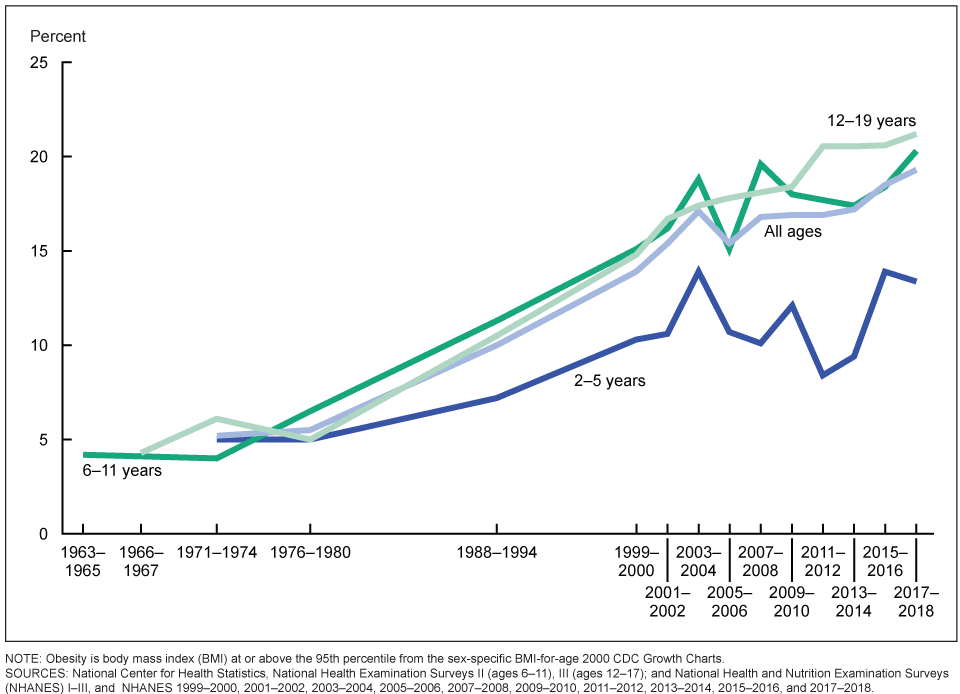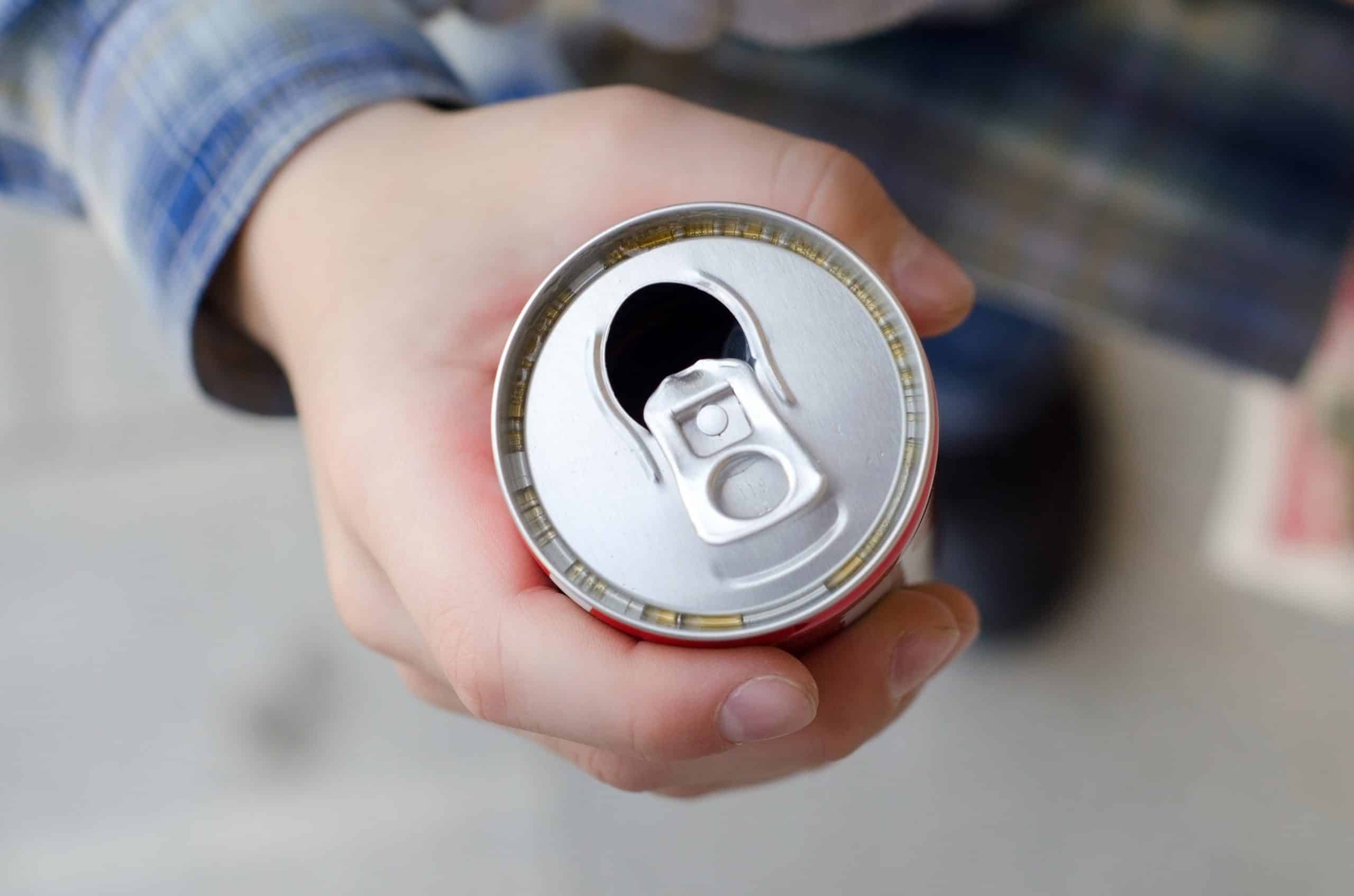March was National Nutrition Month in the US, which focuses on the critical importance of making informed choices about food and eating habits, as well as physical activity. On this topic, a speaker at the recent NextMedHealth conference shared that American children now consume over 65 pounds of added sugar per year. That amount of sugar can fill a bathtub.
It hasn’t always been like this. The speaker also shared that in the 1800s, children only consumed one pound of sugar per year.
I was appalled.
It’s well established that excess caloric intake from non-nutritious sources, such as that from added sugar, promotes overweight and obesity. As the CDC’s chart below highlights—and as popular news headlines have touted over the years—obesity among children, at increasingly young ages, is rising at a horrific rate.

Source: CDC
Drinks are the largest source of added sugar for kids
The American Heart Association highlights that the largest portion (47%) of added sugar children consume comes from beverages. Soft drinks are the leading offender, but fruit and sports drinks, as well as coffee and tea are also contributors. Snacks and sweets play the next biggest role at 31%.
This made me wonder, “Who is combating this awful statistic? Where are the innovators in this space promoting greater health for our children and for the future of our nation?”
Luckily, there are many organizations seeking to change the landscape of children’s packaged food in order to make it healthier. Once Upon a Farm, Serenity Kids, Little Spoon, and many more are capitalizing on the growth in the organic baby food market as more parents demand healthier, whole food alternatives for their kids. And these companies are pledging not to add sugar to their products. This market is expected to be worth $6.34 billion by 2028, which represents a compound annual growth rate of 8.7% from 2022 to 2028.
While it’s exciting that there are increasing numbers of options for health-focused consumers, they are often more expensive than conventional choices, which means they aren’t readily available to everyone.
And which organizations are tackling the largest offenders: the beverages children consume? While, yes, water; sparkling water; and flavored, no-sugar/no-sweetener water options are in the market, they aren’t being adopted en masse. While we’ve seen declines over time, children’s consumption of sugary drinks (SSBs) remains high.
There are also considerable disparities in consumption, with higher-income white children consuming fewer SSBs than their Black and Hispanic counterparts. This is a health equity issue that begs another question, “Why do disparities in consumption persist, and how can we reduce SSB consumption across the board to drive better health outcomes, and a better future, for our children?”
To effectively reduce consumption, we need a different approach than we’ve taken to get to this point. Perhaps the first question to ask isn’t, “Which innovators are combating this issue?” But instead it’s, “How are innovators combating this issue, and what questions are they asking to do so?”
Asking better questions: An alternative to traditional product innovation
Clayton Christensen once stated, “Questions are places in your mind where answers fit. If you haven’t asked the question, the answer has nowhere to go.” In order to address the present issue of over-consumption of sugar, we must ask effective questions. By doing so, we will drive effective product innovation.
As the theory of Jobs to Be Done highlights, products and services are most successful when they are developed around an individuals’ desired progress. But in order to design such a product or service, an innovator must uncover that desired progress. In this situation, there are some key questions we must ask in order to identify what solution (i.e., product, service, or intervention) will help reduce SSB consumption, and thus improve health outcomes.
Because, let’s be honest. This has been a problem for decades, and despite new products entering the market, we haven’t reduced consumption enough to improve health.
Channeling Christensen’s advice, we shouldn’t assume we know the answer, especially in a situation where many of the innovators are not the ones plagued by the problem of overconsumption. To get at the desired progress that leads individuals to (in Jobs to Be Done language) “hire” SSBs, we would do well to perform a Jobs to Be Done analysis.
Once innovators have gathered a cohort of families—including both adults and children, as adults often influence children’s food and drink selection—innovators should ask each member of the cohort the following questions (caveat: some of the language used in these questions may need to be slightly altered or expanded for children):
- Tell me about the last time you chose to drink a sugar-sweetened beverage such as juice, soda, etc.
- What were you doing right before you drank it?
- Who was there?
- How did you feel?
- Paint the scene for me.
- In deciding to drink this beverage, what alternatives did you consider?
- What was appealing about the alternative beverage?
- What was unappealing about it?
- Tell me about the last time you considered drinking a SSB, but instead chose a non-sugary alternative.
- What were you doing right before you drank it?
- Who was there?
- How did you feel?
- Paint the scene for me.
A jobs analysis requires deep, reflective listening, and building each subsequent question off of the individuals’ prior answers. So, while this set of questions is directional in nature, it’s not exhaustive. If someone answers that they “wanted” the drink, a good follow-up question would uncover what that felt like by using the following prompts: “Describe that feeling to me. What does it feel like to ‘want’ the drink? And how did you feel after you drank it?”
By identifying the forces of progress that are both supporting and inhibiting change, we can identify where the individual struggles. And the struggling moment is the seed of all innovation. If we don’t identify the struggles by asking good questions, we can’t identify effective solutions.
So, even though National Nutrition Month is in the rearview mirror, a health equity topic as critical as this one deserves year-round attention. Will we ask the critical questions to drive improvement, or will we find ourselves in a similar—or worse—situation when next March rolls around?



